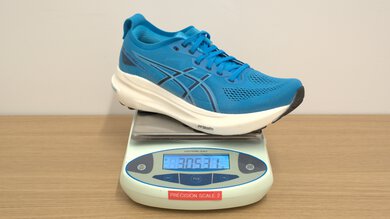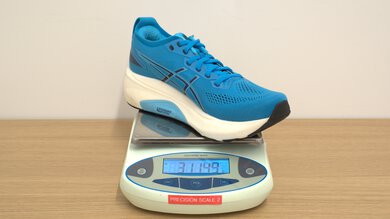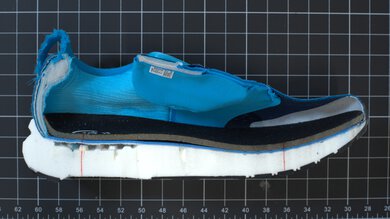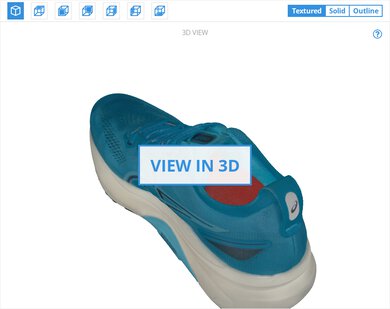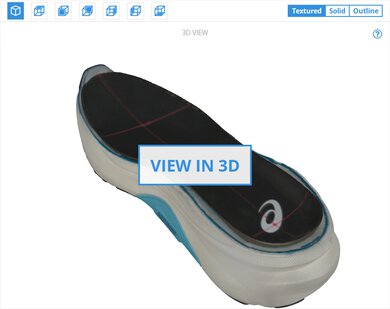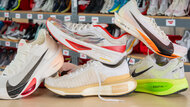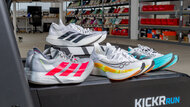The ASICS GEL-KAYANO 31 is one of the longest-running (pun intended) models in the ASICS lineup, having undergone many transformations since the early '90s. This 31st iteration is a premium stability shoe intended for daily training. Like its predecessor, it uses ASICS' relatively new 4D Guidance System, which promises adaptive stability as you run, making use of support elements that include a foam-based midfoot block for arch support and a wider overall platform. This is a large, heavy shoe with a high stack height, but it's a good fit for heavier runners or runners needing a supportive daily trainer.
Our Verdict
The ASICS GEL-KAYANO 31 isn't meant for marathon racing. As a supportive daily trainer, it's not great for picking up the pace. It has poor overall energy return and a heavy weight that you'll feel in the longer distances of a marathon.
-
Feels well-cushioned underfoot.
-
Poor energy return.
-
Heavy.
The ASICS GEL-KAYANO 31 isn't the best choice for 5K/10K racing. Its heavy weight and bulk aren't designed for faster speeds over shorter distances.
-
Poor energy return.
-
Heavy.
The ASICS GEL-KAYANO 31 delivers poor energy return. The midsole foam isn't soft or responsive enough to prevent excessive energy loss, and the shoe doesn't provide the bouncy, responsive ride needed for faster paces.
-
Poor energy return.
The ASICS GEL-KAYANO 31 offers sub-par cushioning overall, but that's mostly due to its limited impact absorption at the forefoot. Its heel, fitted with a PureGEL insert, provides great cushioning and protection underfoot, especially for heavier runners.
-
Great protection under the heel at higher forces.
-
Forefoot cushioning is more limited.
The ASICS GEL-KAYANO 31 has impressive lateral stability. The remarkably wide outsole creates a stable platform, and this shoe uses support elements like a harder foam block in the midfoot for arch support. Though its high stack height lifts you farther off the ground, the firmness of the foam, especially in the forefoot, makes for a very controlled ride.
-
Wide outsole provides a stable platform.
-
4D Guidance System includes elements like a stiff block of foam in the midfoot.
-
Foam is very firm overall.
-
High stack.
- 5.0 Marathon Racing
- 5.2 5K/10K Racing
Performance Usages
- 1.0 Energy Return
- 5.2 Cushioning
- 8.3 Lateral Stability
Changelog
-
Updated Jul 30, 2025:
We revised the phrasing in the Heel Cushioning box to better align with the latest test bench scores and clarify the shoe's purpose and context within the market.
- Updated Jul 30, 2025: We've converted this review to Test Bench 0.8.1, which mainly updates the score components for the Marathon Racing and Lateral Stability usage boxes to improve accuracy.
- Updated Apr 02, 2025: Converted to Test Bench 0.8.
- Updated Apr 02, 2025: Review published.
Check Price
Differences Between Sizes And Variants
We bought and tested the ASICS GEL-KAYANO 31 in men's US size 9, as noted on the label. The pair we purchased is the Digital Aqua/Bright Cyan colorway, but you can also buy the shoe in a wide range of colors, depending on the region. The men's variant ranges from Black/White and Black/Black to Blue Expanse/Digital Aqua and Indigo Blue/Gunmetal, while the women's variant includes colors like Cool Matcha/Light Celadon and Black/Bold Magenta, among others.
There's also a LITE-SHOW variant with reflective glow-in-the-dark elements to increase visibility at night and a PLATINUM variant with metallic accents based on Shibori dyeing techniques.
You can buy this shoe in narrow, regular, wide, or extra wide widths.
Popular Running Shoes Comparisons
The ASICS GEL-KAYANO 31 is a premium stability shoe. It's a great daily trainer for overpronators, with non-intrusive support elements and high-stack cushioning. However, this isn't the shoe to get if you're looking for a lightweight option for speedwork. ASICS also offers the GEL-NIMBUS 27, a premium daily trainer that focuses on impact protection and cushioning.
See our recommendations for the best running shoes to find the perfect model for your needs.
The ASICS GEL-KAYANO 31 and ASICS GEL-NIMBUS 27 are both daily trainers offering high cushioning and comfort, but they serve slightly different runner profiles. The GEL-NIMBUS 27 is a neutral max-cushion trainer focused on plushness and impact absorption, delivering a very soft underfoot experience that excels on easy runs and recovery days. Its smooth, pillowy ride makes it ideal for runners who prioritize comfort and don't mind a bit of extra weight for the sake of protection. The GEL-KAYANO 31, on the other hand, is ASICS' flagship stability model, designed for runners who need extra lateral support. Thanks to its new 4D Guidance System, it provides stability without harsh posting or stiff medial foam. The ride is firmer than the Nimbus, especially at the forefoot, and it lacks some protection for longer runs.
The ASICS GEL-KAYANO 31 and ASICS GEL-NIMBUS 26 are both popular and long-standing models in ASICS' lineup, but they suit different needs. The GEL-KAYANO 31 is aimed at runners who need more stability, with dedicated support elements and a slightly wider outsole. The GEL-NIMBUS 26, on the other hand, is a more neutral daily trainer designed for maximum comfort, with a slightly higher stack height and more balanced cushioning in the heel and forefoot.
The ASICS NOVABLAST 4 is a more well-rounded shoe than the ASICS GEL-KAYANO 31. It's significantly lighter and uses more responsive foam, making it better for faster paces. It isn't as stable as the GEL-KAYANO 31, which is a better fit for heavier runners or those who need support elements.
For most runners, the New Balance FuelCell Rebel v4 has some advantages over the ASICS GEL-KAYANO 31. It's a significantly lighter shoe that has some ground feel due to its much lower stack height than the GEL-KAYANO. Thanks to its more responsive foam, the New Balance is a bit more efficient and better at picking up the pace. The GEL-KAYANO is still a better fit for runners who prefer higher stacks or need a stability shoe.
The Altra Torin 7 and the ASICS GEL-KAYANO 31 are both daily trainers emphasizing stability, catering to runners seeking support during their runs. The GEL-KAYANO 31 offers even higher stability, featuring a wider base at the arch. However, this comes with added weight, making the GEL-KAYANO 31 heavier than the Torin 7. Another key difference is the heel-to-toe drop: the ASICS features a high drop, whereas the Altra offers a zero-drop platform.
Test Results
The shoe's PureGEL midsole insert was displaced when cutting it, but we've included a picture of the PureGEL beneath the shoe so you can see what it looks like.
The heel doesn't return a lot of energy. The shoe's firmer foam absorbs a lot of impact, resulting in high energy loss, meaning that the GEL-KAYANO 31 lacks the propulsive feel of high-performance racers.
The forefoot has similarly poor energy return. Ultimately, this shoe doesn't provide a very bouncy experience due to the firmness of its foam.
The heel offers decently fair cushioning overall. It can provide some underfoot protection for heel strikers and heavier runners, but if you're looking for a very plush and pillowy experience, look towards true max-cushioned shoes like the Mizuno Neo Vista 2.
Unlike the heel, the forefoot doesn't provide the same level of cushioning, so the experience isn't as soft and protected under the forefoot.
The heel is fairly firm. Lighter runners and forefoot strikers are more likely to feel that firmness, providing some stability. However, there's more give at higher forces, making for a softer landing in the heel if you're on the heavier side.
The forefoot, meanwhile, is incredibly firm. That makes for a very stable ride, creating a rigid platform for toe-offs. However, runners who prefer a soft, forgiving landing might find the forefoot too rigid.
Check Price
Comments
ASICS GEL-KAYANO 31: Main Discussion
Let us know why you want us to review the product here, or encourage others to vote for this product.
Update: We revised the phrasing in the Heel Cushioning box to better align with the latest test bench scores and clarify the shoe’s purpose and context within the market.


